Comparative Study of WebRTC Open Source SFUs
for Video Conferencing
Emmanuel Andr´e∗, Nicolas Le Breton∗§, Augustin Lemesle∗§, Ludovic Roux∗ and Alexandre Gouaillard∗
∗CoSMo Software, Singapore, Email: {emmanuel.andre, ludovic.roux, alex.gouaillard}@cosmosoftware.io
§CentraleSup´elec, France, Email: {nicolas.lebreton, augustin.lemesle}@supelec.fr
Abstract—WebRTC capable media servers are ubiquitous, and
among them, Selective Forwarding Units (SFU) seem to generate
more and more interest, especially as a mandatory component
of WebRTC 1.0 Simulcast. The two most represented use cases
implemented using a WebRTC SFU are video conferencing
and broadcasting. To date, there has not been any scientific
comparative study of WebRTC SFUs. We propose here a new
approach based on the KITE testing engine. We apply it to the
comparative study of five main open-source WebRTC SFUs, used
for video conferencing, under load. The results show that such
approach is viable, and provide unexpected and refreshingly new
insights on the scalability of those SFUs.
Index Terms—WebRTC, Media Server, Load Testing, Real-
Time Communications
I. INTRODUCTION
Nowadays, most WebRTC applications, systems and ser-
vices support much more than the original one-to-one peer-to-
peer WebRTC use case, and use at least one media server to
implement them.
For interoperability with pre-existing technologies like SIP
for Voice over IP (VoIP), Public Switched Telephone Network
(PSTN), or Flash (RTMP), which can only handle one stream
of a given type (audio, video) at a time, one requires media
mixing capacities and will choose a Multipoint Control Unit
(MCU) [1]. However, most of the more recent media servers
are designed as Selective Forwarding Units (SFU) [2]; a design
that is not only less CPU intensive on the server, but that also
allows for advanced bandwidth adaptation with multiple en-
coding (simulcast) and Scalable Video Coding (SVC) codecs.
The latter of these allow for even better resilience against
network quality problems like packet loss.
Even when solely focusing on use cases that are imple-
mentable with an SFU, there are still many other remaining.
Arguably, the two most popular use cases are video confer-
ence (many-to-many, all equally receiving and sending), and
streaming / broadcasting (one-to-many, with one sending and
many receiving).
While most of the open-source (and closed-source) Web-
RTC media servers have implemented testing tools (see section
II-A), most of those tools are specific to the server they test,
and cannot be reused to test others or to make a comparative
study. Moreover, the published benchmarks differ so much in
terms of methodology that direct comparison is impossible. So
far, there has not been any single comparative study of media
servers, even from frameworks that claim to be media server
and signalling agnostic.
In this paper, we will focus on scalability testing of a video
conference use case using a single WebRTC SFU media server.
The novelty here is the capacity to run exactly the same test
scenario in the same conditions against several different media
servers installed on the same instance type. To compare the
performance of each SFU for this use case, we report the
measurements of their bit rates and of their latency all along
the test.
The rest of the paper is structured as follows: section II
provides a quick overview of the state of the art of WebRTC
testing. Section III describes, in detail, the configurations,
metrics, tools and test logic that were used to generate the
results presented in section IV, and analyzed in section V.
II. BACKGROUND
Verification and Validation (V&V) is the set of techniques
that are used to assess software products and services [3]. For
a given software, testing is defined as observing the execution
of the software on the specific subset of all possible inputs and
settings and provide an evaluation of the output or behavior
according to certain metrics.
Testing of web applications is a subset of V&V, for which
testing and quality assurance is especially challenging due
to the heterogeneity of the applications [4]. In their 2006
paper, Di Lucca and Fasolino [5] categorize the different types
of testing depending on their non-functional requirements.
According to them, the most important are performance, load,
stress, compatibility, accessibility, usability and security.
A. Specific WebRTC Testing tools
A lot of specific WebRTC testing tools exist; for instance,
the media server (e.g.
tools that assume something about
signalling) or the use cases (e.g. broadcasting) they test.
WebRTCBench [6] is an open-source benchmark suite in-
troduced by University of California, Irvine in 2015. This
framework aims at measuring performance of WebRTC peer-
to-peer (P2P) connection establishment and data channel /
video calls. It does not provide for the testing of media servers.
The Jitsi team have developed Jitsi-Hammer [7], an ad-hoc
traffic generator dedicated to testing the performance of their
open source Jitsi Videobridge [8].
The creators of Janus gateway [9] have developed an ad-
hoc tool
to assess their gateway performance in different
configurations. From this initial assessment, they proposed
Jattack [10], an automated stressing tool for the analysis
�
of performance and scalability of WebRTC-enabled servers.
In their paper, they claim that Jattack is generic and that it can
be used to assess the performance of WebRTC gateways other
than Janus. However, without the code being freely available,
this could not be verified.
Most of the tools coming from the VoIP world assume
SIP as the signalling protocol and will not work with other
signaling protocols (XMPP, MQTT, JSON/WebSockets).
WebRTC-test [11] is an open source framework for func-
tional and load testing of WebRTC on RestComm; a cloud
platform aimed at developing voice, video and text messaging
applications.
Finally, Red5 has re-purposed an open source RTMP load
test tool called “bees with machine guns” to support WebRTC
[12].
B. Generic WebRTC Testing
In the past few years, several research groups have ad-
dressed the specific problem of generic WebRTC testing. For
instance, having a testing framework or engine that would
be agnostic to the operating system, browser, application,
network, signaling, or media server used. Specifically, the
Kurento open source project (Kurento Testing Framework) and
the KITE project have generated quite a few articles on this
subject.
1) Kurento Testing Framework a.k.a. ElasTest:
In [13], the authors introduce the Kurento Testing Frame-
work (KTF), based on Selenium and WebDriver. They mix
load-testing, quality testing, performance testing, and func-
tional testing. They apply it on a streaming/broadcast use case
(one-to-many) on a relatively small scale: only the Kurento
Media Server (KMS) was used, with one server, one room
and 50 viewers.
In [14], the authors add limited network instrumentation
to KTF. They provide results on the same configuration as
above with only minor modifications (NUBOMEDIA is used
to install the KMS). They reach 200 viewers at the cost of
using native applications (fake clients that implement only the
WebRTC parts responsible of negotiation and transport, not
the media processing pipeline). Using fake clients generates
different traffic and behavior, introducing a de-facto bias in
the results.
In [15], the authors add to KTF (renamed ElasTest) support
for testing mobile devices through Appium. It is not clear
whether they support mobile browsers and, if they do, which
browsers and on which OS, or mobile apps. They now
recommend to install KMS through OpenVidu, and propose
to extend the WebDriver protocol to add several APIs. While
WebDriver protocol implementation modifications are easy on
the Selenium side, on the browser-side they would require the
browser vendors to modify their (sometimes closed-source)
WebDriver implementations, which has never happened in the
past.
2) Karoshi Interoperability Test Engine: KITE:
The KITE project, created and managed by companies
actively involved in the WebRTC standard, has also been very
AWS instance type
Rationale
RAM
Dedicated bandwidth
Media Server VM
c4.4xlarge
Cost effective instance
with dedicated comput-
ing capacity
30 GB
2 Gbps
Client VM
c4.xlarge
Cost effective instance
with dedicated comput-
ing capacity (4 vCPU)
7.5 GB
750 Mbps
TABLE I: VMs for the media servers and the clients.
active in the WebRTC testing field with an original focus on
compliance testing for the WebRTC standardization process
at W3C [16]. KITE is running around a thousand tests across
21+ browsers / browser revisions / operating systems / OS
revisions on a daily basis. The results are reported on the
official webrtc.org page.1
In the process of WebRTC 1.0 specification compliance
testing, simulcast testing required using an SFU to test against
(see the specification2 chapter 5.1 for simulcast and RID,
and section 11.4 for the corresponding example). Since there
was no reference WebRTC SFU implementation, it has been
decided to run the simulcast tests in Chrome browser against
the most well-known of the open source SFUs.
3) Comparison and Choice:
KTF has been understandingly focused on testing the KMS
from the start, and only ever exhibited results in their publi-
cations about testing KMS in the one-to-many use case.
KITE has been designed with scalability and flexibility in
mind. The work done in the context of WebRTC 1.0 simulcast
compliance testing paved the way for generic SFU testing
support.
We decided to extend that work to comparatively load
test most of the open-source WebRTC SFUs, in the video
conference use case, with a single server configuration.
III. SYSTEM UNDER TEST AND ENVIRONMENT
A. Cloud and Network Settings
All tests were done using Amazon Web Services (AWS)
Elastic Compute Cloud (EC2). Each SFU and each of its
connecting web client apps were run on separate Virtual
Machines (VMs) in the same AWS Virtual Private Cloud
(VPC) to avoid network fluctuations and interference. The
instance types for the VMs used are described in Table I.
B. WebRTC Open Source Media Servers
We set up the following five open-source WebRTC SFUs,
using the latest source code downloaded from their respective
public GitHub repositories (except for Kurento/OpenVidu, for
which the Docker container was used), in a separate AWS EC2
Virtual Machine and with default configuration:
• Jitsi Meet (JVB version 0.1.1077)3
• Janus Gateway (version 0.4.3)4 with plugin/client web
app5
1https://webrtc.org/testing/kite/
2https://www.w3.org/TR/webrtc/
3https://github.com/jitsi/jitsi-meet
4https://github.com/meetecho/janus-gateway
5https://janus.conf.meetecho.com/videoroomtest.html
�
Fig. 1: Configuration of the tests.
• Medooze (version 0.32.0)6 with plugin/client web app7
• Kurento/OpenVidu (from Docker container, Kurento Me-
dia Server version 6.7.0)8 with plugin/client web app9
• Mediasoup (version 2.2.3)10
Note that on Kurento, the min and max bit rates are hard-
coded at 600,000 bps in MediaEndpoint.java at line 276. The
same limit is 1,700,000 bps for Jitsi, Janus, Medooze and
Mediasoup as seen in Table IV column (D).
We did not modify the source code of the SFUs, so these
sending limits remained active for Kurento and Jitsi when
running the tests.
The five open-souce WebRTC SFUs tested use the same
signalling transport protocol (WebSockets) and do not differ
enough in their signalling protocol to induce any measurable
impact in the chosen metrics. They all implement WebRTC,
which means they all proceed through discovery, handshake
and media transport establishment exactly the same standard
way, respectively using ICE [17], JSEP [18] and DTLS-SRTP
[19].
C. Web Client Applications
To test the five SFUs with the same parameters and to
collect useful information (getStats see section III-E and full
size screen captures), we made the following modifications to
the corresponding web client apps:
• increase the maximum number of participants per meet-
ing room to 40
• support for multiple meeting rooms, including roomId
and userId in the URL
• increase sending bit rate limit to 5,000,000 bps (for Janus
only, as it was configurable on the client web app)
• support for displaying up to 9 videos with the exact same
dimensions as the original test video (540×360 pixels)
6https://github.com/medooze/mp4v2.git
7https://github.com/medooze/sfu/tree/master/www
8https://openvidu.io/docs/deployment/deploying-ubuntu/
9https://github.com/OpenVidu/openvidu-tutorials/tree/master/openvidu-js-
node
10https://www.npmjs.com/package/mediasoup
Fig. 2: Screenshot of Janus Video Room Test web app after
modifications.
• removal or re-positioning of all
the text and images
overlays added by the client web app so that they are
displayed above each video area
• expose the JavaScript RTCPeerConnection objects to call
getStats() on.
Each client web app is run on a dedicated VM, which
has been chosen to ensure there will be more than enough
resources to process the 7 videos (1 sent and 6 received).
A Selenium node, instrumenting Chrome 67, is running on
each client VM. KITE communicates with each node, through
a Selenium hub, using the WebDriver protocol (see Fig. 1).
Fig. 2 shows a screenshot of the modified Janus Video Room
web client application with the changes described above.
The sender video is displayed at the top left corner of the
window. The received videos received from each of the six
remote clients are displayed as shown on Fig. 2. The original
dimensions of the full image with the 7 videos are 1980×1280
pixels. The user id, dimension and bit rates are displayed above
the video leaving it free of obstruction for quality analysis.
D. Controlled Media for Quality Assessment
As the clients are joining a video conference, they are
supposed to send video and audio. To control the media that
each client sends and in order to make quality measurements,
we use Chrome fake media functionality. The sender and each
client play the same video.11 Chrome is launched with the
following options to activate the fake media functionality:
• allow-file-access-from-files
• use-file-for-fake-video-capture=
e-dv548_lwe08_christa_casebeer_003.y4m
• use-file-for-fake-audio-capture=
e-dv548_lwe08_christa_casebeer_003.wav
• window-size=1980,1280
11Credits
for
aka
Take One
on Alternageek.com,
the video file used:
Linuxchic
“Internet personality Christa
Casebeer,
02,”
by Christian Einfeldt. DigitalTippingPoint.com https://archive.org/details/e-
dv548 lwe08 christa casebeer 003.ogg
The original file, 540×360 pixels, encoded with H.264 Constrained Baseline
Profile 30 fps for the video part, has been converted using ffmpeg to
YUV4MPEG2 format keeping the same resolution of 540×360 pixels, colour
space 4:2:0, 30 fps, progressive. Frame number has been added as an overlay
to the top left of each frame, while time in seconds has been added at the
bottom left. The original audio part, MPEG-AAC 44100 Hz 128 kpbs, has
been converted using ffmpeg to WAV 44100 Hz 1411 kbps.
�
Number of rooms
(7 participants
in a room)
Number of
client VMs
Jitsi
Janus Medooze Kurento Mediasoup
40
70
70
280
490
490
20
140
70
490
TABLE II: Load test parameters per SFU.
The last option (window-size) was set to be large enough to
accommodate 7 videos on the screen with original dimensions
of 540×360 pixels.
E. Metrics and Probing
1) Client-side: getStats() function:
The test calls getStats() to retrieve all of the statistics values
provided by Chrome. The bit rates for the sent video, and all
received videos, are computed by KITE by calling getStats
twice (during ramp-up) or 8 times (at load reached) using the
byteReceived and timestamp value of the first and last
getStats objects.
2) Client-side: Video Verification:
Once a
corresponding video is displayed and it is not a still or a blank
image). No failure was reported concerning the display of the
sender video. However, there have been some failures for the
videos received from the 6 clients of a room.
The failure rate is very high for Jitsi at 81% because in
most cases still images are displayed instead of the video
(correspondingly the measured bit rates are zero). There is
also a high failure rate of 43% for Janus and 42% for Kurento
as many clients are missing one or more videos.
(a) Jitsi
B. Bit Rates Measurements
Bit rates measured for the sender’s video and the average
of the 6 valid receivers’ videos in a room during the whole
experiment are presented separately per SFU in Fig. 3, while
Fig. 4a gives the graphs of the average reception bit rates of
the 6 valid receivers. Zero or null bit rates are not included in
the computation of the average, e.g. if the client only received
3 videos out of the 6, the values in Fig. 3 and in Fig. 4a are
the average of those 3 videos.
It is clearly visible on Fig. 4a that Kurento has a hard-coded
maximum bit rate of 600,000 bps, while the four other SFUs
are able to use all the available bandwidth.
Apart from Kurento, all the SFUs have a rather similar
behaviour regarding the average bit rate measured at receiver
side. At some point, when the number of users to be served
keeps increasing, the bit rate starts to decrease. This reduction
in receiving bit rate happens first for Medooze at about 195
users, then for both Janus and Mediasoup at about 270 users.
Jitsi simply stops sending any video when the number of users
reaches 245, so at that point the bit rate drops down to zero.
In Fig. 3 we can see more finely the difference of behaviour
of each SFU with the increase of number of rooms and partic-
ipants. In these charts, the blue graph “number of participants”
shows the increase of users with time. Each step means the
addition of one room and 7 users to the test.
Ideally, this blue graph should have a very regular linear
pattern. In reality, we can see some steps that are very long,
which means that for a long time no new room has been
added to the test. This is due to the video check that fails.
The creation of a new room happens only when video check
is successful for the current room (see validation check in
subsection III-F2) or after a timeout set at 7 minutes (one
minute timeout per video).
Fig. 3a is about Jitsi. The number of rooms and users
increases very smoothly up to 34 rooms and 238 users. But
when the 35th room is added, Jitsi seems to collapse: bitrate
drops down to zero, and the check for validating the videos
on the 35th room lasts for a very long time until a timeout.
For Janus, Fig. 3b, the number of rooms and users increases
regularly for most of the test. However, from room 39 and
subsequently, it takes a little more time to get all the 7 videos
of a room to be displayed. It takes a very long time for room
60 only, then Janus is able to manage the additional rooms up
to the target load of 70 rooms.
Medooze, Fig. 3c, achieve handling the load increase up
to target load. However, at the beginning of the test it has
(b) Janus
(c) Medooze
(d) Kurento
(e) Mediasoup
Fig. 3: Transmission bit rates.
�
difficulties from time to time to have all of the 7 participants
in a room to be up and active as one or more videos are
missing
Kurento transmission bit rates are reported on Fig. 3d. Most
of the time, check for videos in the latest created room takes
a long time until timeout, except at the beginning of the test
for the 10 first rooms.
At last Mediasoup, Fig. 3e, exhibits a very regular pattern
for the number of participants graph, except for the second and
the thirtieth rooms where a missing video delays the creation
of the next room until timeout occurs.
Table IV gives an overview of the sender’s video statistics
collected on each client during the ramp-up phase of the
load test. Looking at the average sending bit rate over time
(column (E)), all the SFUs have a high average sending bit rate
ranging from 1 Mbps (Medooze) to 1.6 Mbps (Janus). Only
Kurento has a much lower bit rate of about 350 kbps. This
can be explained in part because of its hard coded bandwidth
limitation of 600,000 bps, and also because more than half of
the video checks fail (see Table III).
The statistics about the bit rates for the 6 videos received
by each client during ramp-up are reported in Table V. Here
again, we notice a large difference between Kurento with a
bit rate of roughly 300 kbps for the clients, and the other
four SFUs for which the receiving bit rate ranges from about
1 Mbps (Medooze) to about 1.6 Mbps (Janus).
When target load is reached (Table VI), there are no data
for Jitsi as videos are no more transmitted once the number of
participants is above 245. On average, for Janus, sending bit
rate is 1.18 Mbps and receiving bit rate is almost 1 Mbps at
target load. For Mediasoup, the sending bit rate is 700 kbps
and receiving bit rate is about 680 Mbps. For Medooze,
both sending and receiving bit rates are much lower at about
215 kbps. At last, Kurento has a sending bit rate of 250 kbps
and receiving bit rate of about 120 kbps.
C. Latency Measurements
Fig. 4b gives an overview of RTT for the whole duration of
the test. Note we had to use a logarithmic scale for this figure.
Similarly as for the bit rates, variation of RTT is relatively
similar for all the SFUs except Kurento.
Some detailed figures for the sender are only reported for
RTT during ramp-up in Table IV column (F) and at target load
in Table VI column (A). During ramp-up, Jitsi, Medooze and
Mediasoup have a latency below 20 ms., for Janus it is 61 ms.,
while for Kurento it is already above half a second.
At target load, both Medooze and Mediasoup keep a low
latency lower than 50 ms., for Janus it is 268 ms., and for
Kurento it is slightly above one second.
D. Video Quality Assessment
Estimation of video quality scores is presented in Fig. 4c.
One may expect video quality to deteriorate as the average
bit rate measured falls down, but the graphs of video quality
remain remarkably flat until the end of the test. This counter
intuitive result is explained by the ability of modern video
(a) Average reception bit rates for the 6 valid receivers.
(b) Average round-trip time for the 6 valid receivers (logarithmic
scale).
(c) Average video quality scores.
Fig. 4: Results over the number of participants.
codecs to make a video weight 15 to 30 times less than the
original uncompressed video while still keeping a quality that
is perceived as very good. For our test, each Chrome browser
has encoded the video with VP8 before sending it to the SFU.
After several experiments with ffmpeg, we noticed that the
quality of the video we used for this load test becomes to be
visibly damaged when the bit rate is set at about 150 kbps or
lower. At target load, average bit rate for Medooze is about
215 kbps. This is still enough to transfer the selected video
with a good perceived quality.
Kurento video quality varies awkwardly according to the
load. It deteriorates almost immediately and reaches its lowest
image quality at about 100 participants. Surprisingly,
the
image quality improves as more participants join the test, up
�
to about 130 participants, before dropping again.
V. ANALYSIS
This study exhibits interesting behaviours of the five SFUs
that have been evaluated when they have to handle an increas-
ing number of rooms and peers in a video conference use
case.
Kurento is plagued by both a hard coded maximum band-
width and a high RTT problem. When the number of partici-
pants is above 42, RTT rises sharply to reach and stay at about
one second. The bit rate, already very low at the start of the
test because of the hard coded limitation, falls quickly above
49 participants to a very low value before improving a little
above 100 participants. Interestingly, video quality, which was
worsening since the beginning of the test, starts to get better
at about 100 participants just when the bit rates improve. But
this improvement lasts only until 130 participants have joined
the test.
Jitsi has some internal problem that makes it suddenly stop
transmitting videos when there are more than 245 peers in the
test.
All the three other SFUs tested behave roughly in a similar
way. Bit rate is maintained at the same level while the number
of peers increases, then at some point bit rate start to decrease.
It happens first to Medooze at about 190 peers. Janus and
Mediasoup are able to keep the maximum level of bit rate
for a higher load as the decrease of bit rate starts above
280 peers. We note also that the decrease of bit rate is sharper
for Medooze.
VI. CONCLUSION AND FUTURE WORK
We have shown that it is now possible to comparatively test
WebRTC SFUs using KITE. Several bugs and oddities have
been found and reported to their respective team in the process.
This work was focused on the testing system, and not on
the tests themselves. In the future we would like to add more
metrics and tests on client side, for example to assess audio
quality as well, and to run the tests on all supported browsers
to check how browser specific WebRTC implementations make
a difference. On the server side, we would like to add CPU,
RAM and bandwidth estimation probes to assess the server
scalability on load.
We would like to extend this work to variations of the video
conferencing use cases by making the number of rooms and
the number of users per rooms a variable of the test run. That
would allow to reproduce the results of [7] and [10].
We would like to extend this work to different use cases,
for example broadcasting / streaming. That would allow,
among other things, to reproduce the results from the Kurento
Research Team.
ACKNOWLEDGMENT
We would like to thanks Boris Grozev (Jitsi), Lorenzo
I˜naki Baz Castillo (Mediasoup), Sergio
Miniero (Janus),
Murillo (Medooze), Lennart Schulte (callstats.io), Lynsey
Haynes (slack) and other Media server experts who provided
live feedback on early result during CommCon UK 2018.
We would also like to thanks Boni Garc´ıa for discussions
around the Kurento Team Testing research results.
REFERENCES
[1] M. Westerlund and S. Wenger, RFC 7667: RTP Topologies, IETF, Nov.
2015. [Online]. Available: https://datatracker.ietf.org/doc/rfc7667/
[2] B. Grozev, L. Marinov, L. Marinov, and E. Ivov, “Last N: relevance-
based selectivity for forwarding video in multimedia conferences,” in
Proceedings of the 25th ACM Workshop on Network and Operating
Systems Support for Digital Audio and Video, 2015.
[3] A. Bertolino, “Software testing research: Achievements, challenges,
dreams,” in Future of Software Engineering, 2007.
[4] Y.-F. Li, P. K. Das, and D. L. Dowe, “Two decades of web application
testing — a survey of recent advances,” Information Systems, 2014.
[5] G. A. Di Lucca and A. R. Fasolino, “Testing web-based applications:
The state of the art and future trends,” Information and Software
Technology, 2006.
[6] S. Taheri, L. A. Beni, A. V. Veidenbaum, A. Nicolau, R. Cammarota,
J. Qiu, Q. Lu, and M. R. Haghighat, “WebRTCBench: A benchmark for
performance assessment of WebRTC implementations,” in 13th IEEE
Symposium on Embedded Systems for Real-time Multimedia, 2015.
[7] Jitsi-Hammer, a traffic generator
for Jitsi Videobridge.
[Online].
Available: https://github.com/jitsi/jitsi-hammer
[8] B. Grozev
and
E.
Ivov.
evaluation.
performance-evaluation/
[Online]. Available:
Jitsi
videobridge
performance
https://jitsi.org/jitsi-videobridge-
[9] A. Amirante, T. Castaldi, L. Miniero, and S. P. Romano, “Performance
analysis of the Janus WebRTC gateway,” in EuroSys 2015, Workshop on
All-Web Real-Time Systems, 2015.
[10] ——, “Jattack: a WebRTC load testing tool,” in IPTComm 2016,
Principles, Systems and Applications of IP Telecommunications, 2016.
[11] WebRTC-test, framework for functional and load testing of WebRTC.
[Online]. Available: https://github.com/RestComm/WebRTC-test
[12] Red5Pro load testing: WebRTC and more.
[Online]. Available:
https://blog.red5pro.com/load-testing-with-webrtc-and-more/
[13] B. Garc´ıa, L. Lopez-Fernandez, F. Gort´azar, and M. Gallego, “Analysis
of video quality and end-to-end latency in WebRTC,” in IEEE Globecom
2016, Workshop on Quality of Experience for Multimedia Communica-
tions, 2016.
[14] B. Garc´ıa, L. Lopez-Fernandez, F. Gort´azar, M. Gallego, and M. Paris,
“WebRTC testing: Challenges and practical solutions,” IEEE Communi-
cations Standards Magazine, 2017.
[15] B. Garc´ıa, F. Gort´azar, M. Gallego, and E. Jim´enez, “User impersonation
as a service in end-to-end testing,” in MODELSWARD 2018, 6th
International Conference on Model-Driven Engineering and Software
Development, 2018.
[16] A. Gouaillard and L. Roux, “Real-time communication testing evolu-
tion with WebRTC 1.0,” in IPTComm 2017, Principles, Systems and
Applications of IP Telecommunications, 2017.
[17] A. Keranen, C. Holmberg, and J. Rosenberg, RFC 8445: Interactive
Connectivity Establishment (ICE): A Protocol
for Network Address
Translator (NAT) Traversal, IETF, July 2018. [Online]. Available:
https://datatracker.ietf.org/doc/rfc8445/
[18] J. Uberti, C.
Jennings,
and E. Rescorla,
Establishment Protocol [draft
IETF, Oct. 2017.
Available: https://tools.ietf.org/html/draft-ietf-rtcweb-jsep-24/
IETF],
JavaScript Session
[Online].
[19] D. McGrew and E. Rescorla, RFC 5764: Datagram Transport Layer
Security (DTLS) Extension to Establish Keys for the Secure Real-time
Transport Protocol (SRTP), IETF, May 2010. [Online]. Available:
https://datatracker.ietf.org/doc/rfc5764/
[20] A. Lemesle, A. Marion, L. Roux, and A. Gouaillard, “NARVAL, a no-
reference video quality tool for real-time communications,” in Proc. of
Human Vision and Electronic Imaging, Jan. 2019, [submitted].
[21] A. Mittal, A. K. Moorthy, and A. C. Bovik, “No-reference image
quality assessment in the spatial domain,” IEEE Transactions on Image
Processing, 2012.
[22] N. D. Narvekar and L. J. Karam, “A no-reference image blur metric
based on the cumulative probability of blur detection (CPBD),” IEEE
Transactions on Image Processing, 2011.
�
SFU
(A) Available send
bandwidth (bps)
MIN
(value > 0 only)
MAX
Average
% bit rate > 1 Mbps
(columns (A) to (E))
% RTT > 50 ms
(column (F))
Jitsi
Janus
Medooze
Kurento
Mediasoup
Jitsi
Janus
Medooze
Kurento
Mediasoup
Jitsi
Janus
Medooze
Kurento
Mediasoup
Jitsi
Janus
Medooze
Kurento
Mediasoup
113,118
744,557
92,471
34,476
93,617
8,342,878
5,000,000
9,130,857
600,000
7,184,000
2,830,383
4,210,276
2,309,558
369,775
2,326,640
65.4%
98.9%
47.4%
0.0%
77.6%
(B) Actual
encoder bit
rate sent (bps)
153,952
676,624
79,440
28,088
91,488
2,397,504
2,081,072
2,782,136
893,912
2,049,872
1,360,703
1,647,705
1,000,979
335,393
1,385,142
65.4%
98.4%
47.4%
0.0%
76.1%
(C) Transmit
bit rate
sent (bps)
156,744
690,904
83,184
32,272
95,576
2,544,144
2,108,224
4,660,656
1,003,728
2,088,776
1,392,607
1,677,538
1,045,173
359,979
1,416,096
65.7%
98.4%
47.8%
0.8%
76.9%
(D) Target
(E) Average
encoder bit bit rate video
sent (bps)
130,881
611,518
94,565
35,501
93,860
2,218,333
1,963,089
4,052,553
676,504
2,131,814
1,388,670
1,682,062
1,044,573
359,540
1,414,368
65.7%
98.9%
48.6%
0.0%
76.3%
rate sent (bps)
113,118
744,557
92,474
34,476
93,617
1,700,000
1,700,000
1,700,000
600,000
1,700,000
1,362,722
1,641,714
1,009,288
356,457
1,401,947
65.4%
98.4%
47.8%
0.0%
77.6%
(F) Sender
googRtt (ms)
1
1
1
1
1
168
435
103
2,371
688
18
61
10
576
18
6.4%
27.8%
1.9%
59.3%
6.5%
TABLE IV: Ramp-up phase: Overview of the sender’s video statistics collected on each web client
Values in columns (A), (B), (C), (D), (E), (F) as per getStats.
Average
SFU
Jitsi
Janus
Medooze
Kurento
Mediasoup
Video receive Video receive Video receive Video receive Video receive Video receive
client 6
1,264,753
992,048
984,617
329,671
1,312,928
57.9%
58.0%
41.4%
0.0%
69.6%
TABLE V: Ramp-up phase: Average bit rates (in bps) for the 6 videos received on each of the 6 clients in a room.
For client i: avgBitrate = ((bytesReceived at t2)−(bytesReceived at t1))×8000
client 2
1,266,195
1,599,621
1,034,351
293,876
1,367,255
58.9%
95.6%
49.1%
0.0%
72.7%
client 3
1,294,939
1,609,458
1,002,854
286,889
1,378,114
60.4%
96.2%
47.8%
0.0%
74.9%
client 4
1,282,719
1,597,015
1,052,769
326,107
1,378,644
60.4%
96.7%
51.4%
0.0%
74.5%
client 1
1,256,874
1,612,145
1,044,738
284,624
1,384,331
54.6%
96.7%
50.7%
0.0%
73.9%
client 5
1,239,218
1,576,674
966,064
344,997
1,375,112
58.6%
94.4%
42.6%
0.0%
73.7%
% bit rate > 1 Mbps Medooze
Kurento
Mediasoup
Jitsi
Janus
timestamp at t2−timestamp at t1
SFU
(A) Sender
googRtt (ms)
MIN
(value > 0 only)
MAX
Average
Jitsi
Janus
Medooze
Kurento
Mediasoup
Jitsi
Janus
Medooze
Kurento
Mediasoup
Jitsi
Janus
Medooze
Kurento
Mediasoup
% RTT > 50 ms
(column (A))
Jitsi
Janus
% bit rate > 1 Mbps Medooze
Kurento
(columns (B) to (H))
Mediasoup
n/a
13
1
144
1
n/a
1,794
131
2,344
803
n/a
268
19
1,052
48
n/a
93.7%
4.2%
100.0%
23.1%
(B) Sender
transmit
bit rate (bps)
n/a
564,512
86,864
65,560
30,272
n/a
2,254,864
627,328
596,336
1,933,720
n/a
1,239,144
222,004
253,297
787,675
n/a
99.5%
58.4%
63.6%
91.6%
(C) Video
receive
client 1
n/a
575,744
85,139
33,544
25,031
n/a
1,700,033
425,070
476,430
1,608,261
n/a
1,007,965
224,558
126,523
706,256
n/a
92.0%
65.5%
5.9%
93.5%
(D) Video
receive
client 2
n/a
514,087
88,002
42,949
25,931
n/a
1,603,051
599,465
471,115
1,624,194
n/a
1,015,112
222,902
124,644
693,924
n/a
90.8%
63.4%
5.9%
93.7%
(E) Video
receive
client 3
n/a
411,512
90,285
43,964
28,374
n/a
1,508,647
504,749
278,106
1,619,031
n/a
1,006,940
220,621
120,520
701,539
n/a
93.2%
60.7%
5.1%
93.9%
(F) Video
receive
client 4
n/a
533,318
87,321
38,414
39,130
n/a
1,542,904
419,465
472,683
1,604,730
n/a
1,014,453
214,895
134,441
705,602
n/a
91.8%
63.4%
7.6%
93.7%
(G) Video
receive
client 5
n/a
596,490
96,191
44,892
22,948
n/a
1,539,257
505,301
231,422
1,616,282
n/a
1,019,429
218,703
118,047
698,421
n/a
94.1%
59.2%
3.4%
92.9%
(H) Video
receive
client 6
n/a
584,226
66,047
31,274
25,088
n/a
1,524,721
426,254
225,831
1,631,401
n/a
1,019,508
215,345
122,425
693,795
n/a
79.3%
56.7%
1.7%
89.4%
TABLE VI: Target load reached: Sender’s RTT (in ms) and transmit bit rates (in bps), and average bit rates for the 6 videos
received, at the end of the test, when all the meeting rooms have been created and all clients are connected to the SFU.
�
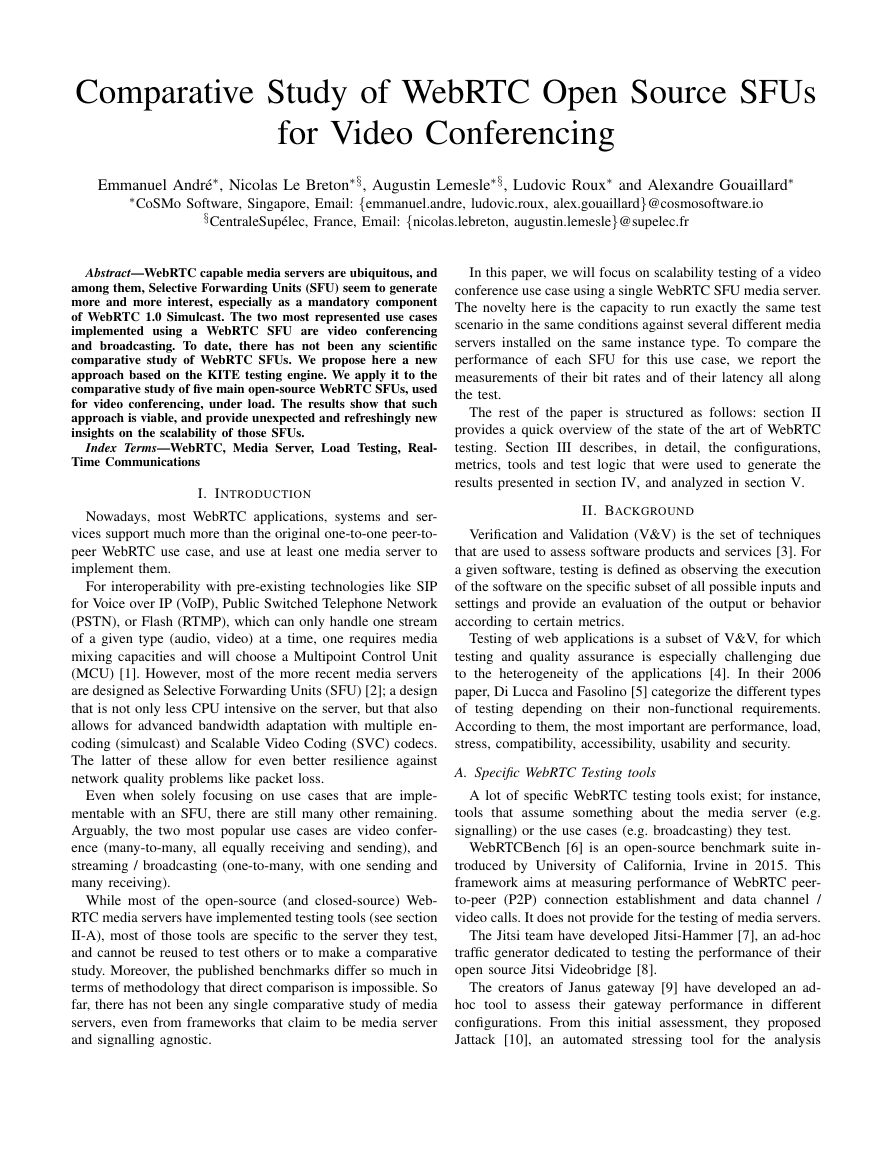
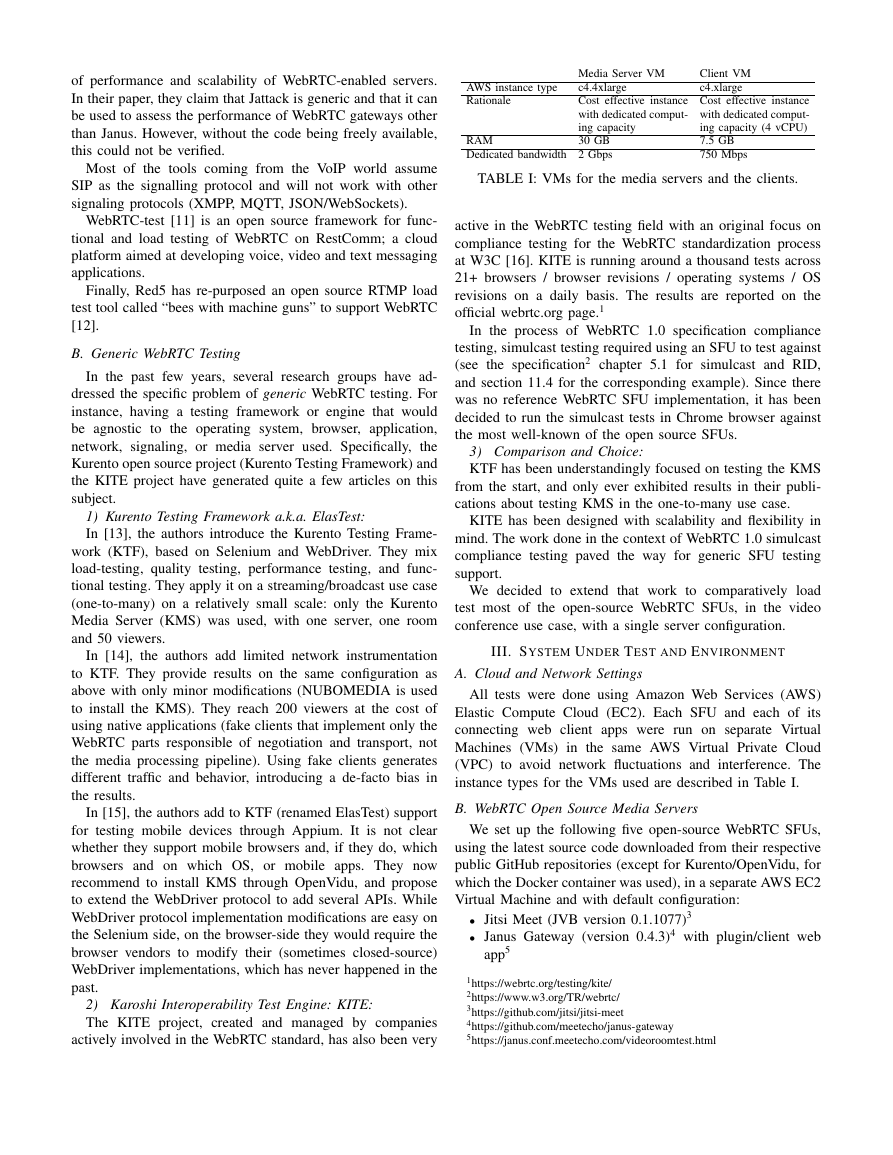

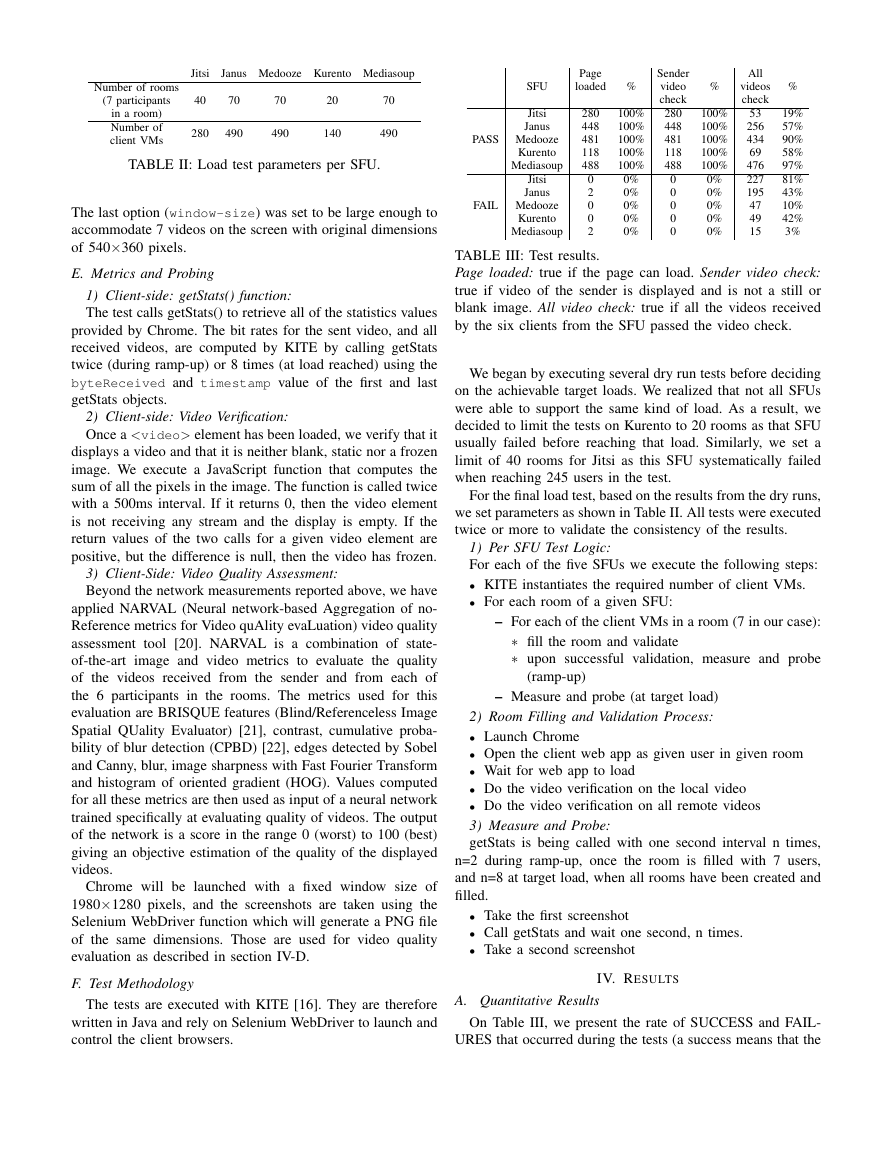
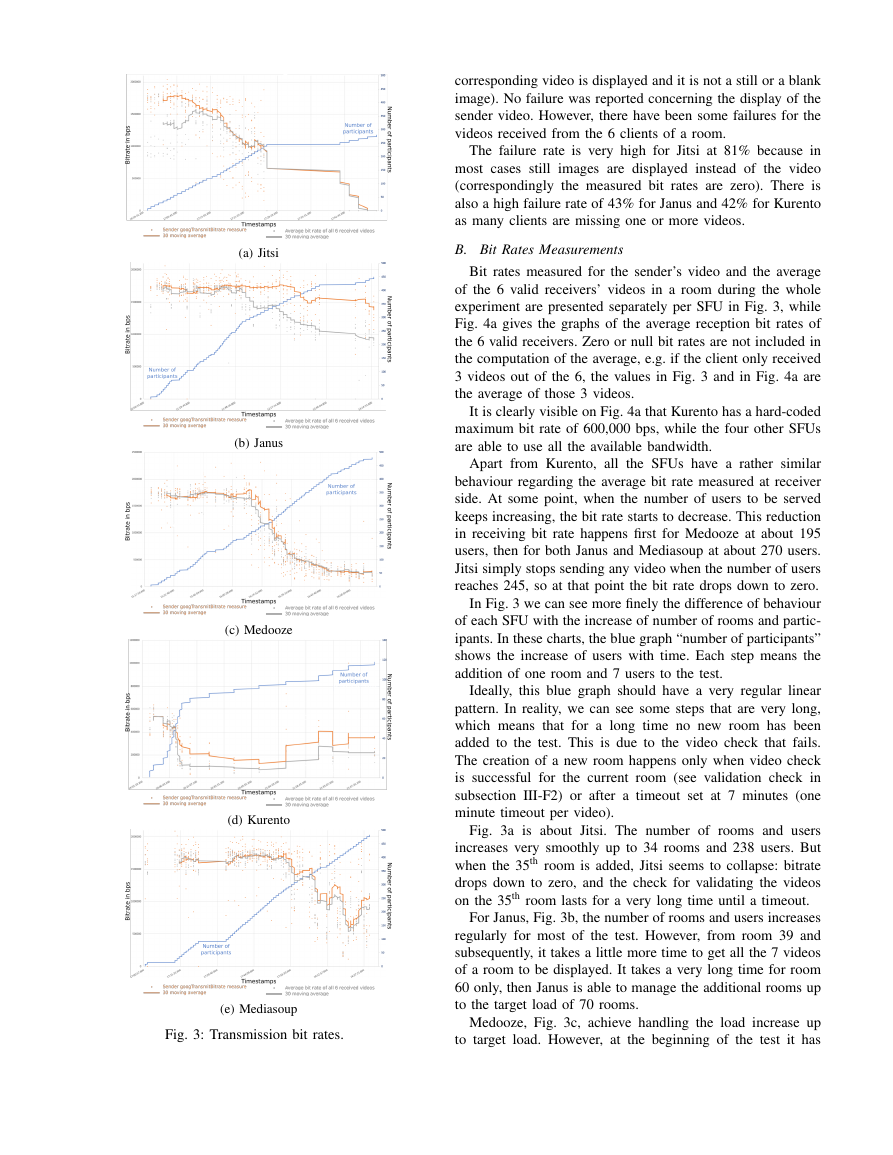
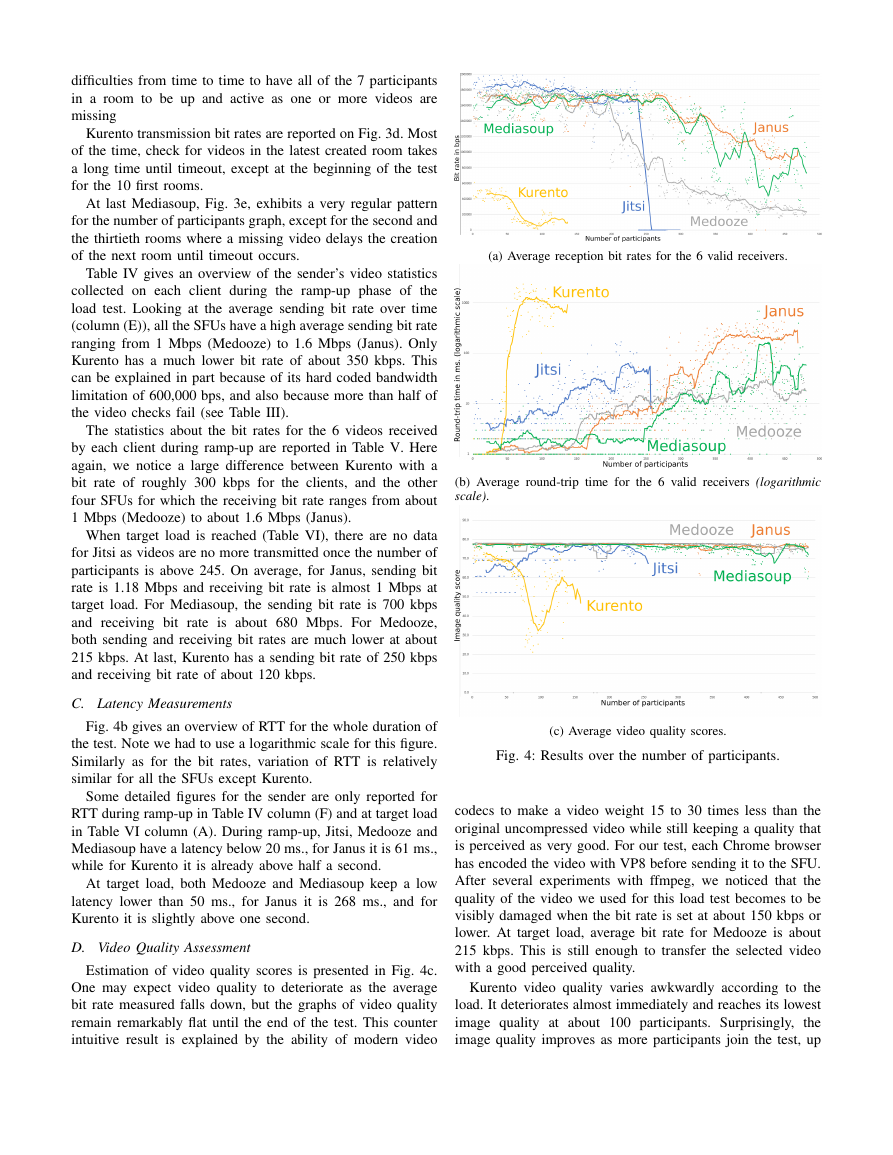

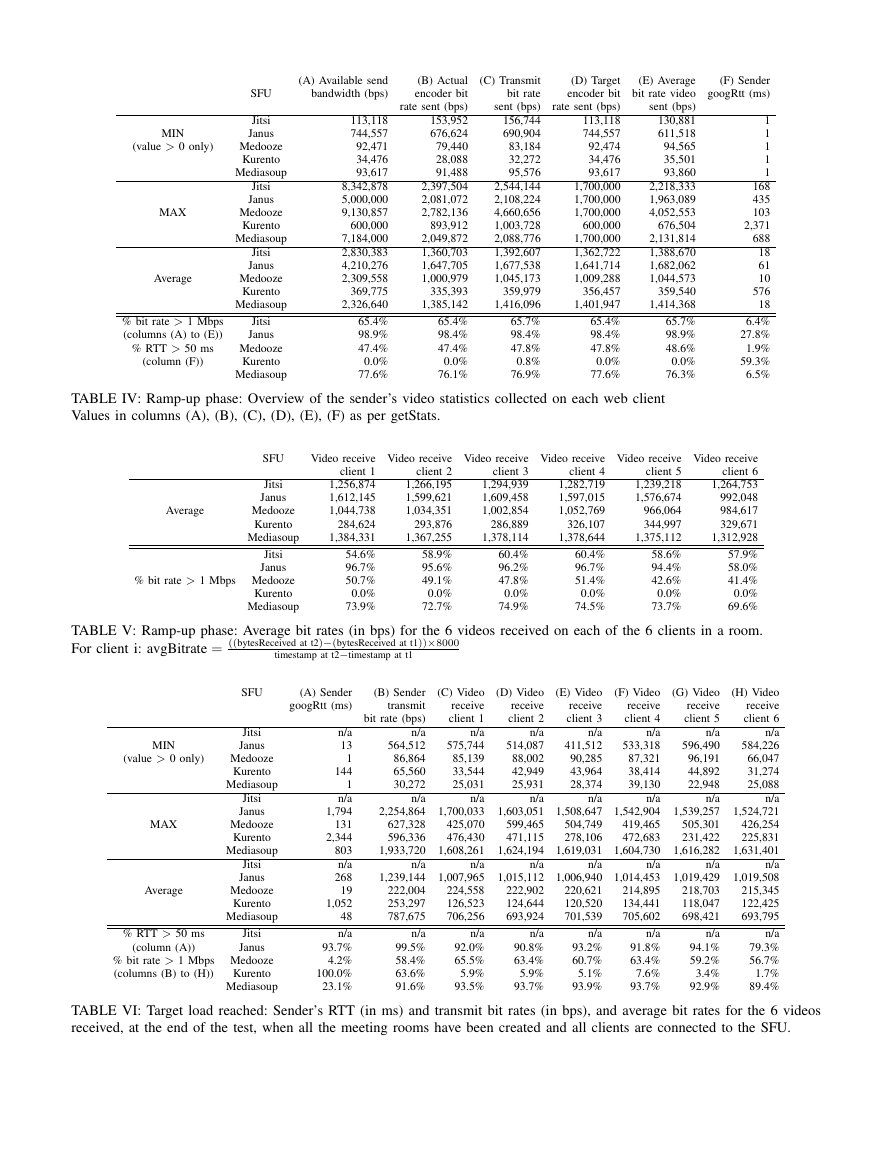








 2023年江西萍乡中考道德与法治真题及答案.doc
2023年江西萍乡中考道德与法治真题及答案.doc 2012年重庆南川中考生物真题及答案.doc
2012年重庆南川中考生物真题及答案.doc 2013年江西师范大学地理学综合及文艺理论基础考研真题.doc
2013年江西师范大学地理学综合及文艺理论基础考研真题.doc 2020年四川甘孜小升初语文真题及答案I卷.doc
2020年四川甘孜小升初语文真题及答案I卷.doc 2020年注册岩土工程师专业基础考试真题及答案.doc
2020年注册岩土工程师专业基础考试真题及答案.doc 2023-2024学年福建省厦门市九年级上学期数学月考试题及答案.doc
2023-2024学年福建省厦门市九年级上学期数学月考试题及答案.doc 2021-2022学年辽宁省沈阳市大东区九年级上学期语文期末试题及答案.doc
2021-2022学年辽宁省沈阳市大东区九年级上学期语文期末试题及答案.doc 2022-2023学年北京东城区初三第一学期物理期末试卷及答案.doc
2022-2023学年北京东城区初三第一学期物理期末试卷及答案.doc 2018上半年江西教师资格初中地理学科知识与教学能力真题及答案.doc
2018上半年江西教师资格初中地理学科知识与教学能力真题及答案.doc 2012年河北国家公务员申论考试真题及答案-省级.doc
2012年河北国家公务员申论考试真题及答案-省级.doc 2020-2021学年江苏省扬州市江都区邵樊片九年级上学期数学第一次质量检测试题及答案.doc
2020-2021学年江苏省扬州市江都区邵樊片九年级上学期数学第一次质量检测试题及答案.doc 2022下半年黑龙江教师资格证中学综合素质真题及答案.doc
2022下半年黑龙江教师资格证中学综合素质真题及答案.doc